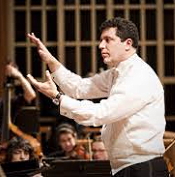By Karl W. Nehring
 Program (all compositions by Eriks Esenvalds): 1. O salutaris hostia (2009) (Text: St. Thomas Aquinas, 1224/25-1274); 2. The Heavens' Flock (2014) (Text: Paulann Petersen, b 1942); 3. Translation (2016) (Text: Paulann Petersen); 4. My Thoughts (2019) (Text: Saint Silouan the Athonite, 1866-1938); 5. Vineta; (Text: Wilhelm Muller, 1794-1827); 6. The Legend of the Walled-in Woman (2009) (Text: Albanian folk song and Vendit Tem ["My Land"] by Martin Camaj 1925-1992, English translation by R. Eksie, 1950-2017); 7. In paradisum (2012) (Text: Catholic Liturgy).
Program (all compositions by Eriks Esenvalds): 1. O salutaris hostia (2009) (Text: St. Thomas Aquinas, 1224/25-1274); 2. The Heavens' Flock (2014) (Text: Paulann Petersen, b 1942); 3. Translation (2016) (Text: Paulann Petersen); 4. My Thoughts (2019) (Text: Saint Silouan the Athonite, 1866-1938); 5. Vineta; (Text: Wilhelm Muller, 1794-1827); 6. The Legend of the Walled-in Woman (2009) (Text: Albanian folk song and Vendit Tem ["My Land"] by Martin Camaj 1925-1992, English translation by R. Eksie, 1950-2017); 7. In paradisum (2012) (Text: Catholic Liturgy).A few weeks ago, I enthusiastically recommended a disc of indescribably beautiful choral music (The Suspended Harp of Babel) by the virtually unknown late Estonian composer Cyrillus Kreek. Sticking with indescribably beautiful choral music by Baltic composers, this time around I am recommending a newly released recording by the better-known (but still hardly a household name) young Latvian composer, Eriks Esenvalds (b. 1977).
 |
| Eriks Esenvalds |
As the album opens, we hear a soaring soprano voice hovering above the sound of the choir. The sound quality is pure and natural, making us feel as though we are being ushered into a sacred space of beauty and rest. The soft "amen" at the end is at once resigned and triumphant (Sperry notes that after more than "three minutes of continuous staggered breathing, the choir gets one communal breath before the final, 'Amen'."). The following piece, The Heavens' Flock, finds the male voices in the choir gaining more prominence. There is an echoing effect toward the end that is simply gorgeous. Moving on to the third selection, Translation, the overall arrangement shifts again, with male and female solo voices singing the lyrics above a wordless accompaniment by the choir. As the piece progresses, an uncredited organist provides some soft background playing, the piece ending quietly with a fade from the organ and background voices.
 |
| Ethan Sperry |
The next track, Vineta, is the most overtly expressive composition on the album in both musical and sonic terms. Sperry explains that "Vineta is a legendary city consumed by the Baltic Sea because of its citizens' hedonistic tendencies, and whose church bells still ring from beneath the surface of the waters calling sailors to their deaths." The piece opens with bells and chimes accompanying the choir. A couple of minutes in, there are some deep organ pedal notes. Later, the bells return, with the choir contributing some wordless vocals. As the piece develops, the choir starts singing lyrics again. There are more bells, more notes from the organ, plenty of marvelous sounds to give your audio system a thorough workout. The organ fades, the bells come back, the choir then takes over, with the percussion instruments joining back in before the fade at the end. That is a sadly inelegant bare-bones account of what is a truly remarkable, complex, stunning composition.
 |
| Portland State Chamber Choir |
Not only is the program outstanding, but so is the production. Former Stereophile editor John Atkinson played a key role in the recording process. In fact, there is an insightful discussion of how the album was engineered by Jason Serinus in that magazine's June 2020 issue. It is well worth perusing to gain more insight into the recording process, which involves both science and art. Although I certainly stand guilty of casting some aspersions at Stereophile over the years, I have always had great respect for Mr. Atkinson. In my admittedly few correspondences with him, he has always been a true gentleman, and his genuine love for and appreciation of music -- especially our beloved British classical music -- has always been exemplary. Bravo, John!
The liner notes by conductor Sperry are helpful, lyrics are included, and the recorded program is nearly 70 minutes long. The musicians, engineers, production staff, and the folks at Naxos have all done themselves proud with this fine release.
KWN
To listen to a brief excerpt from this album, click below:








No comments:
Post a Comment
Thank you for your comment. It will be published after review.